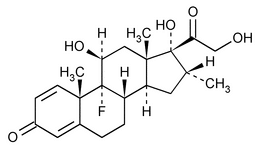Dexamethasone
(dex'' a meth' a sone).
Pregna-1,4-diene-3,20-dione, 9-fluoro-11,17,21-trihydroxy-16-methyl-, (11
9-Fluoro-11
» Dexamethasone contains not less than 97.0 percent and not more than 102.0 percent of C22H29FO5, calculated on the dried basis.
Packaging and storage—
Preserve in well-closed containers.
Identification—
B:
Ultraviolet Absorption  197U
197U —
—
Solution:
10 µg per mL.
Medium:
methanol.
Absorptivities at 239 nm, calculated on the dried basis, do not differ by more than 3.0%.
Loss on drying  731
731 —
Dry it at 105
—
Dry it at 105 for 3 hours: it loses not more than 0.5% of its weight.
for 3 hours: it loses not more than 0.5% of its weight.
Residue on ignition  281
281 :
not more than 0.2% from 250 mg.
:
not more than 0.2% from 250 mg.
Chromatographic purity—
Formate buffer—
Dissolve 1.32 g of ammonium formate in 1 L of water, adjust with formic acid to a pH of 3.6, and mix.
Mobile phase—
Prepare a filtered and degassed mixture of Formate buffer and acetonitrile (67:33). Make adjustments if necessary (see System Suitability under Chromatography  621
621 ).
).
Test solution—
Transfer about 180 mg of Dexamethasone, accurately weighed, to a 100-mL volumetric flask, dissolve in and dilute with acetonitrile to volume, and mix. Transfer about 33 mL of this solution to a 100-mL volumetric flask, dilute with Formate buffer to volume, and mix.
Chromatographic system
(see Chromatography  621
621 )—The liquid chromatograph is equipped with a 254-nm detector and a 4.6-mm × 25-cm column that contains packing L11. The flow rate is about 1 mL per minute. Chromatograph the Test solution, and record the peak responses as directed for Procedure: the column efficiency is not less than 5000 theoretical plates.
)—The liquid chromatograph is equipped with a 254-nm detector and a 4.6-mm × 25-cm column that contains packing L11. The flow rate is about 1 mL per minute. Chromatograph the Test solution, and record the peak responses as directed for Procedure: the column efficiency is not less than 5000 theoretical plates.
Procedure—
Inject a volume (about 10 µL) of the Test solution into the chromatograph, record the chromatogram, and measure the peak responses. Calculate the percentage of each impurity in the portion of Dexamethasone taken by the formula:
100(ri / rs)
in which ri is the peak response for each impurity, and rs is the sum of the responses of all peaks: not more than 1.0% of any individual impurity is found, and not more than 2.0% of total impurities is found.
Assay—
Mobile phase—
Prepare a suitable degassed solution of water and acetonitrile (about 7:3) such that at an approximate flow rate of 2 mL per minute, the retention time of Dexamethasone is about 7 minutes.
Standard preparation—
Prepare a solution of USP Dexamethasone RS in methanol having a known concentration of about 7.5 mg per mL. Dilute an accurately measured volume of this solution with the Mobile phase to obtain a Standard preparation having a known concentration of about 0.3 mg per mL.
Assay preparation—
Using 30 mg of Dexamethasone, proceed as directed for Standard preparation.
Procedure—
Introduce equal volumes (between 15 and 30 µL) of the Assay preparation and the Standard preparation into a high-pressure liquid chromatograph (see Chromatography  621
621 ) operated at room temperature by means of a suitable microsyringe or sampling valve, adjusting the operating parameters such that the peak obtained with the Standard preparation is 60% full-scale. Typically, the apparatus is fitted with a 4-mm × 25-cm column containing packing L7, is equipped with an UV detector capable of monitoring absorption at 254 nm and a suitable recorder, and is operated at about 1000 psi. Five replicate injections of the Standard preparation show a relative standard deviation of not more than 3.0%. Determine the peak responses, at equivalent retention times, obtained with the Assay preparation and the Standard preparation, and calculate the quantity, in mg, of C22H29FO5 in the portion of Dexamethasone taken by the formula:
) operated at room temperature by means of a suitable microsyringe or sampling valve, adjusting the operating parameters such that the peak obtained with the Standard preparation is 60% full-scale. Typically, the apparatus is fitted with a 4-mm × 25-cm column containing packing L7, is equipped with an UV detector capable of monitoring absorption at 254 nm and a suitable recorder, and is operated at about 1000 psi. Five replicate injections of the Standard preparation show a relative standard deviation of not more than 3.0%. Determine the peak responses, at equivalent retention times, obtained with the Assay preparation and the Standard preparation, and calculate the quantity, in mg, of C22H29FO5 in the portion of Dexamethasone taken by the formula:
100C(rU / rS)
in which C is the concentration, in mg per mL, of USP Dexamethasone RS in the Standard preparation, and rU and rS are the peak responses obtained from the Assay preparation and the Standard preparation, respectively.
Auxiliary Information—
Please check for your question in the FAQs before contacting USP.
| Topic/Question | Contact | Expert Committee |
|---|---|---|
| Monograph | Domenick Vicchio, Ph.D.
Senior Scientific Liaison 1-301-998-6828 |
(SM42010) Monographs - Small Molecules 4 |
| Reference Standards | RS Technical Services 1-301-816-8129 rstech@usp.org |
USP35–NF30 Page 2836

